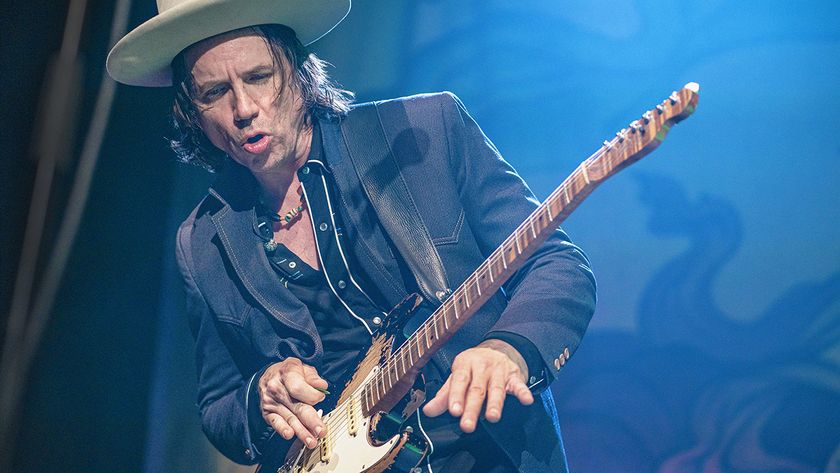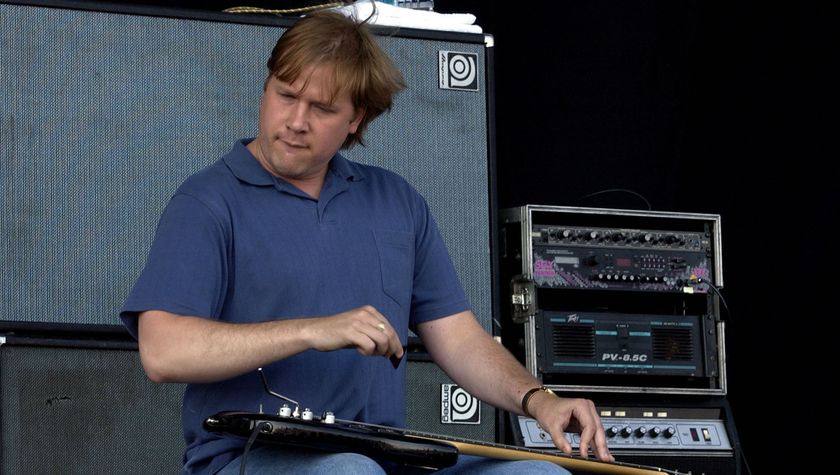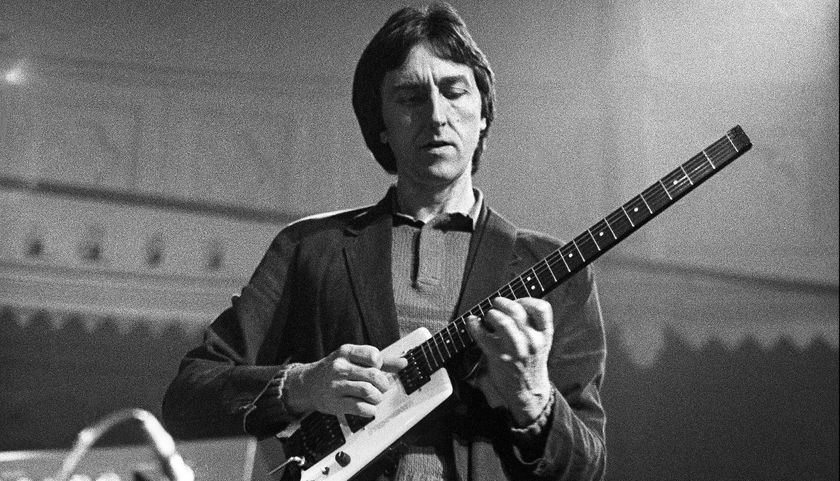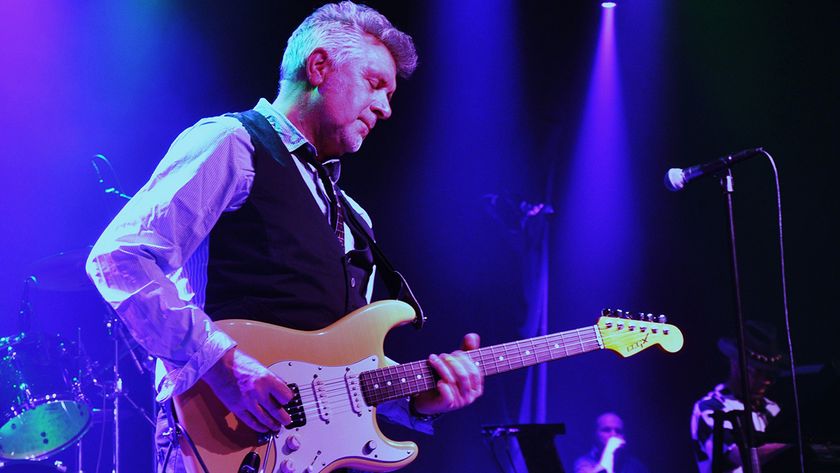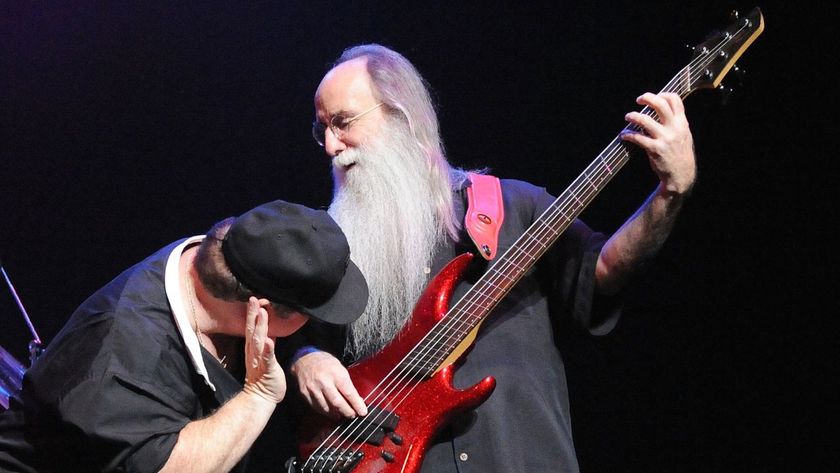Iron Maiden’s Dave Murray, Adrian Smith and Janick Gers share the guitar strategies behind their epic new album
How three complementary guitar styles were critical to mapping out the expansive arrangements on Senjutsu
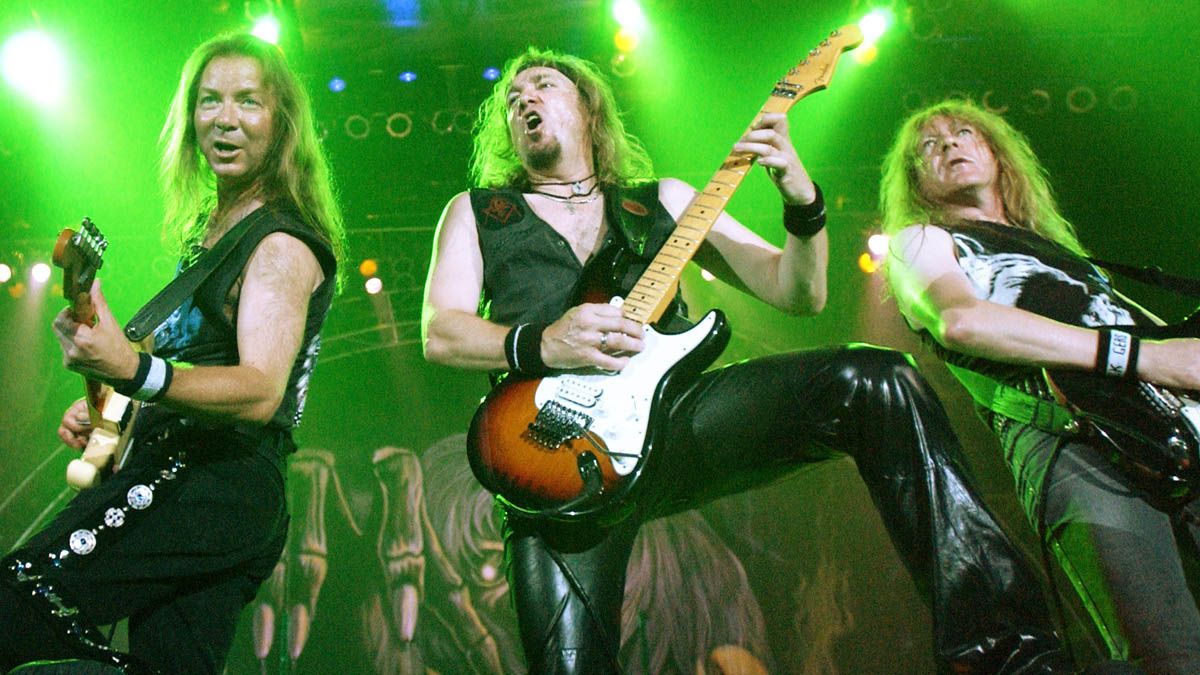
Dave Murray is laughing at Guitar World’s question, and, honestly, we can’t really blame him. We’ve connected with the Iron Maiden guitarist to discuss his iconic metal band’s new record, Senjutsu.
It’s an epic double album bursting with complex, head-spinning guitar action – and we’ve just asked him to pick out its single most challenging six-string moment. “Anything that sounds difficult… was difficult to play!” he says with a chuckle.
Murray’s good-natured jibe aside, Senjutsu is a truly formidable work of art. The New Wave of British Heavy Metal trailblazers’ 17th album is a 10-song, 80-plus-minute collection of classic Maiden grandeur and inimitable triple-guitar assault, courtesy of Murray and his compatriots Adrian Smith and Janick Gers.
It’s stacked with Iron Maiden’s signature calling cards: dual-guitar harmonies, soaring solos, galloping rhythms, loud-soft dynamics and more merge with enthralling lyrical tales to lead listeners on one hell of a headbanging journey.
“Senjutsu is very cinematic,” says Smith of the stirring title track, which features taiko-esque drums, exotic guitar runs and multiple fiery leads. “There’s a lot of dramatics on the album: Days of Future Past has a modern vibe, The Writing on the Wall has a folky vibe. [Bassist-songwriter] Steve [Harris] has come up with some classic stuff. His songs are getting longer and longer. He’s gonna need a triple album next time. [Laughs] But if you’re a Maiden fan, you’re going to love it.”
“Because of our past we’re a band that can afford to do that,” says Gers of Senjutsu’s extended running time. “We take chances. There’s no set three-minute song that goes exactly where you want it. … You can have your fast metal stuff, Death of the Celts where there’s all the Celtic things, the Eastern-kinda [sounds] of The Parchment. You’ve got the huge choruses of Hell on Earth. It all adds to the album. So many ideas – it’s quite breathtaking, really.”
As Gers points out, any Maiden fan knows that the band has a well-established track record of pushing boundaries and continually raising their own creative bar. They helped set the standard for the NWOBHM sound with the one-two punch of their 1980 self-titled debut and the following year’s Killers – before elevating the form to its stadium-filling, album-selling and artistically ambitious heights with their ensuing five-album run of stunners: The Number of the Beast (1982), Piece of Mind (1983), Powerslave (1984), Somewhere in Time (1986) and Seventh Son of a Seventh Son (1988).
Get The Pick Newsletter
All the latest guitar news, interviews, lessons, reviews, deals and more, direct to your inbox!
Iron Maiden continued to follow their own course during the shifting musical trends of the '90s and the new millennium – and they’ve been rewarded. They’ve sold more than 100 million records, headlined thousands of shows across the globe and created some of metal’s most identifiable sounds and imagery, the latter built around their ever-evolving mascot Eddie (whose latest samurai incarnation ties into the themes of Senjutsu – a Japanese term that loosely translates as “tactics and strategy”).
Along the way, they’ve influenced countless musicians – many of whom would become huge stars (including Kirk Hammett, Dimebag Darrell and John Petrucci). Iron Maiden have accomplished all this despite weathering multiple key personnel changes over the years.
Their current long-running lineup – which has been in place since 2000’s Brave New World – consists of bandleader Harris and the Murray/Smith/Gers guitar trio, plus drummer Nicko McBrain and singer Bruce Dickinson.
After nearly five decades as a band, Iron Maiden are an institution, and their legacy is secured. They could easily kick back, release greatest-hits compilations, play exclusive one-off shows – and watch the money roll in. But, Smith says, Maiden’s motivation comes from a different source altogether.
“I suppose you’re trying to prove yourself every time,” he says. “You’re only as good as your last thing. Maybe it’s some sort of deep-seated insecurity? I don’t know. I just like to bring the best I’ve got to the table every time. I try hard. We all do.”
Maiden’s self-directed drive has helped the band hit new creative and commercial heights as they age. Their previous record, 2015’s The Book of Souls, was the group’s first-ever double studio album, and it debuted at Number 1 in more than 43 countries.
In 2018 they launched their most extravagant world tour to date, Legacy of the Beast, which presented a visually arresting experience filled with a career-spanning setlist of fan favorites.
Senjutsu continues the band’s current prolific period. The two-disc behemoth was recorded back in 2019 and was originally supposed to arrive last year. But Covid stopped that plan in its tracks and put a halt to their ongoing Legacy tour. Things were quiet in the Maiden camp until summer 2021, when a few cryptic teasers started to appear online.
In July of this year, Maiden went wide with the announcement of Senjutsu and dropped its rousing single The Writing on the Wall.
The new song – which builds from a vaguely Western-style acoustic guitar line into a larger-than-life anthem – arrived with a stunning apocalypse-themed animated video conceptualized by Dickinson. The Writing on the Wall was written before the coronavirus encircled the globe, but the end-times concepts its video explores are pitch perfect for the unsettling, and often dire, global events of the pandemic era.
When Guitar World connects with the guitarists in August 2021 – Murray dialing in from his home in Hawaii, with Smith and Gers calling from opposite ends of England (south and north, respectively) – the coronavirus has just infected one of their own. Only days before we speak, Dickinson announced that he’d caught a breakthrough case of Covid.
“Bruce picked something up, but I didn’t speak to him yet,” says Gers of the singer, who at press time was recovering at his home in England. “I think he went out for a birthday meal and picked something up from one of his kids. But I think he’s okay, he’s a tough boy. And he’s had all his injections and whatnot, so he should be good.”
Gers, Murray and Smith report that they’ve each managed to remain healthy. “Touch wood,” Smith adds. “I’m very careful… I stay at home a lot anyway.”
The last time Iron Maiden were all in the same room together was when they recorded Senjutsu. The band had a break in the Legacy of the Beast tour, so they booked time with longtime producer Kevin Shirley at Guillaume Tell in Paris – the nearly 100-year-old theater turned recording studio where they cut The Book of Souls. “That room in Paris is amazing,” says Murray. “It was an old art-deco theater: gorgeous, high ceilings and great vibe.”
The studio and producer may have been familiar, but the process of creating Senjutsu looked a bit different from past Maiden records. “Some albums we’ve spent weeks in a rehearsal room working out six, seven songs and then gone into the studio,” Murray continues. “[This time] nothing was rehearsed. When we turned up to Paris, everything was done there on the spot.”
The band members brought in material – from full demo tracks to riff snippets – and began to knock the ideas into full-fledged songs. But instead of strapping on their electrics and cranking their amps, the guitarists broke out their Gibson, Taylor and Martin acoustics.
“We sat down quietly,” Murray says of Senjutsu’s early sessions, for which he employed a Gibson Hummingbird. “Steve had an acoustic bass, we had acoustic guitars and we’d work it all out … scribbling the chords down in our notepad. [Laughs]”
“We take the song in sections, break it down,” Smith adds. “Nicko will sit there with his sticks, playing on his knees, just watching what we’re doing. For sorting out songs, acoustic is the way to go. Especially because the songs we do are quite complex – you can’t just go hell for leather, straight into it.”
With the song foundations in place, the band grabbed their electrics to finalize and record the tracks. Murray’s axe of choice was his sunburst Fender Stratocaster “that I’ve been using live for the last 15, 20 years. It has Seymour Duncans on it… You can pretty much get anything out of it: from clean to heavy.” Like Murray, Gers employed a live mainstay: his custom black Strat outfitted with Seymour Duncan JBs that Fender made him in the '90s.
For his part, Smith says he relied primarily on his custom green Jackson San Dimas with the “really distressed classic maple neck,” plus his custom Jackson 12-string and his “old faithful” Gibson Les Paul Goldtop Deluxe that he’s had since he was 18.
“It’s a great all-singing, all-dancing guitar,” Smith says of the San Dimas. “You can get a real Strat sound out of it [and a] heavy humbucker sound, and you’ve got the whammy bar.”

The guys say they kept their studio setups relatively simple for Senjutsu. They opted for tried-and-true British amplification: Marshall JMP and 2000 valve amp for Murray, JVM for Smith and a 100-watt prototype Marshall built for Gers (based on an old 200-watt monster he used in “the Gillan band back in the day”).
The guitarists often went direct into their amps and preferred minimal effects. “For solos I kicked in a couple pedals, like Uni-Vibes and some phases and flanges,” Murray says, “and Kevin would add some stuff from his magic rack of effects.”
Maiden spent a couple months in Paris tracking Senjutsu, and when the sessions wrapped “everybody went off with grand hopes,” Murray recalls. “We were to get back together and carry on the Legacy of the Beast tour. Then things happened …”
The “things,” obviously, were the coronavirus pandemic and its fallout, which still have much of the music industry (and the world) in a state of sustained disruption. The Legacy of the Beast tour has been pushed back until 2022, but, thankfully, Senjutsu is here to hold us over.
Clearly, it’s been a long journey to get this far – and the guitarists are beyond excited that fans are finally going to hear their latest opus. In the following Q&A, which has been condensed and collated for clarity, Murray, Smith and Gers discuss the roots of Senjutsu, how they weave Maiden’s three-guitar “tapestry,” the benefit of embracing musical imperfections and much more.
The pandemic continues to impact so many people’s lives. Iron Maiden are no exception. Bruce getting sick is the latest unfortunate example. Has the guitar been a good distraction during these uncertain times?
ADRIAN SMITH: “Yeah it was, especially during the first part of it. I did a lot of woodshedding, recording and writing. I went through periods for weeks when I was in the studio every day, playing cover versions, working on my singing… It was a great distraction and outlet during a crazy time.”
DAVE MURRAY: “I’ve been playing more acoustic than electric, actually… just keeping my fingers in semi-match shape. [Laughs] Just playing for the fun of it. If we’re sitting down watching a movie, I’ll have a guitar on my lap to keep my fingers working. I’ve been listening to Django Reinhardt. I love his stuff; he’s amazing. It’s difficult to play and really pushes you. I like that gypsy jazz style of playing because it’s fun, exciting, upbeat and happy… That’s what I’ve been doing to keep my fingers on the pulse.”
JANICK GERS: “I play guitar all the time. I have them all over the house. I pick them up and just muck around… I don’t consider it practice. I’ve never been one of those people to sit and practice for six hours. I play quite a lot, but [I’m not] running over scales. Music’s not that for me. I just enjoy playing guitar to bring the emotions out in your playing.”
When did you start writing for Senjutsu?
SMITH: “I started thinking about the album about a month or two before we went in the studio. I always had recording equipment, going back to the '80s with a little four-track TEAC with the cassettes. I had 2 Minutes to Midnight, Wasted Years that kind of thing on there. Nowadays, Pro Tools is an amazing tool for writing.
“I’m able to bring in fairly sketched-out demos. I had eight or 10 [demos] and various bits or pieces. The main song I had was Senjutsu – with the big Kodo drums at the beginning, going into a very dramatic soundscape. I enjoy the process of seeing a germ of an idea turn into this gigantic sonic wave onstage. It’s really an amazing process… it can be very stressful, though!”
MURRAY: “Sometimes the guys would come in with demos, other times they’d have riffs. Also, a lot of it was worked out in the studio completely from scratch.”
GERS: “There’s no set way we do the writing. The Time Machine, I was intending that to be all acoustic. But I put a guide down on the electric and it sounded so eerie. I thought, Oh, there’s something in there… So we ended up keeping that.”
Senjutsu has some epic compositions on it. Was there a particular song, or guitar moment, that was especially difficult to pull off?
MURRAY: [Laughs] Good question. It’s a lot of heavy riffs and difficult patterns on this album. Complex pieces. A lot of it was getting the timing: If you’re playing a melody line, sometimes you don’t have to be right on the note. You can lag back or push it forward a little bit to create a different kind of feel.
SMITH: “The most difficult ones were the ones I wrote myself, because you’re invested in them so personally. I had a lot of trouble with The Writing on the Wall. You’ve got three guitars playing the same riff – an open D chord – and the intonation is crucial. It’s simple, but it’s got to have the three guitars ringing on that one D chord, and everyone plays the chord slightly differently.
“We started recording and people were like, ‘Oh yeah, it’s going well.’ And I’m like, ‘Nope. It sounds sour and out of tune.’ I’m very sensitive to that. I had to take a break and walk around Paris for a couple hours to get my head straight. [Laughs] I think we ended up having one guitar play through and then the other guys overdubbed it.”
GERS: “I think the challenging thing was the amount of melodies behind the vocal stuff. But it’s not about me. I’m looking to bring the songs together. From that context I think everything seems to fit and it all feels good.”

Janick, following up on your point of playing for the song: how would you say Dave and Adrian’s styles complement your guitar playing in that pursuit?
GERS: “Dave has got a very legato sound to his playing, a much smoother style. Adrian’s very rhythmic in his playing. He has a different sound to what Dave has, probably a bit more spikey. It’s more of a rock-n-roll sound. Then I bring in a ragged, aggressive, edgy sound that can move in a different way than Dave and Adrian.
“When you put those ways of playing together they balance off each other and give it a different texture. You might have one guitar crashing, one chugging, one playing behind the vocal melody – it’s kind of like a tapestry.
“All the guitarists in the band are quite dynamic; we can all pull a solo off if we need to. [But] it’s not about ego, it’s about letting other people step forward and helping the song along. If we were egotistical, it wouldn’t work. It would just be guitar battles flying all over the place. It’s supposed to be about emotion.”
I don’t actually write a lot of guitar harmonies in my stuff... but Steve is crazy for this. He loves guitar harmonies
Adrian Smith
Senjutsu does have a lot of emotionally evocative moments. I’m thinking about The Parchment, the lyrical solos and stirring guitar harmonies.
MURRAY: “There’s some mysterious melodies there. It almost reminds me of a movie soundtrack theme…”
SMITH: “I don’t actually write a lot of guitar harmonies in my stuff. I did a little bit on this album, but Steve is crazy for this. He loves guitar harmonies. I’ll take what he writes and put it into a musically [correct form], and he’ll say, ‘No, that sounds too formal.’ So, he’ll get you to play a harmony and then finish on a unison. Or Dave and I will play something and clash, and he’ll go, ‘Ah no, leave that. I like that.’ So, it’s not just like putting a guitar through a harmonizer – it’s got a different edge to it.’”
You’ve all had long and influential careers with Maiden. What is the biggest area in which you’ve grown as players since you first started?
GERS: “Um, that’s for the people to say, really. [Laughs] I think your guitar playing changes when you get older. There’s no need to go mad all the time. It depends on what the other guitar player is doing. If he’s playing a nice melody there’s no point in you playing the same thing. You’re trying to make the song interesting. It’s not about you.”
SMITH: “As far as composition goes, I seem to be more prolific these days. Years ago, it was a struggle to write something. You’d bring in your ideas and sit there with your guitar [volume] on number one, really clean, and tell the guys, 'Here it goes.' That is difficult. You’re bearing your soul… to a bunch of hairy-ass musicians. [Laughs] But now I can take in my nice Pro Tools demos, and they get the picture straight away.
You don’t need to just play fast to express yourself. As they say: one note sounds better than a thousand notes a lot of the time
Dave Murray
“As far as playing goes, I grew up singing and playing in a band, so I wasn’t focused 100 percent on guitar. My influences were more [a] bluesy kind of rock. Of course, I loved Ritchie Blackmore, but I had no idea what he was doing. [Laughs] I couldn’t play that.
“But Pat Travers, Johnny Winter, Paul Kossoff, the Thin Lizzy guitarists … you could get more of the idea. I took that with me in Maiden the first time. … And Dave taught me some stuff and away I went. Then when I left the band [in 1990] I worked with different people.
“I learned a lot from Roy Z, who was the guitarist in Bruce’s band. [Editor’s note: Dickinson left Maiden in 1993 to focus on his solo career. He rejoined in 1999.] He was very well schooled in technique, and he had a good way of putting it across. It really transformed my playing. So when I rejoined Maiden [in 1999] I felt a lot more confident – especially playing over fast stuff and alternate picking.”
MURRAY: “I think now I feel more open to listen to any type of music. Back then it was blues or rock and that’s it! [Laughs] Now I listen to all sorts of music: jazz and some country rock stuff that’s coming out now, because a lot of it is very heavy. Also, fusion – complicated stuff like Al Di Meola, or anyone who’s playing something you don’t expect.
“I keep going to Django, but that guy was amazing. For guitarists, and all musicians, it’s about expression. You don’t need to just play fast to express yourself. As they say: one note sounds better than a thousand notes a lot of the time. For guitarists, just enjoy what you’re doing. It’s like, guitar should be a form of therapy. And everybody needs that at the moment. [Laughs]”
- Senjutsu is out now via Parlophone / BMG.
Brad is a Brooklyn-based writer, editor and video producer. He is the former content director of Revolver magazine and executive editor of Guitar World. His work has appeared in Vice, Guitar Aficionado, Inked and more. He’s also a die-hard Les Paul player who wishes he never sold his 1987 Marshall Silver Jubilee half stack.

“They said, ‘The Ace Hotel have you on camera leaving with the guitar.’ I was like, ‘I thought it was a gift!’” Machine Gun Kelly on the time he stole a cheap Martin from a hotel – and was billed $5,000

“I had never done that before. I thought Jimmy was going to go, ‘Nice one’ – he looks at me and goes, ‘Don’t you ever do that again’”: That time Chrissie Hynde enraged one of her Pretenders bandmates because she stopped playing mid-gig
















![The Grateful Dead: Pigpen [left] and Jerry Garcia in action at Santa Clara County Fairgrounds in San Jose, May 18, 1968.](https://cdn.mos.cms.futurecdn.net/SiXNMdzjN4PJYWg6TaRqwg-840-80.jpg)
